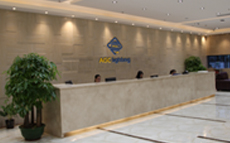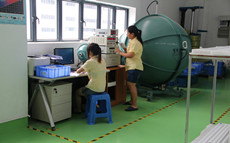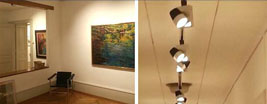Mobile

AGC Lighting mobile phones
official website
Step one: Using a smart phone to install scanning code software, such as "wochacha", "Win on Quick Code” etc.
Step two: Open the scanning code software against the QR code, then you can get an interlinkage.
Step three: open the link, and then enter AGC Lighting Mobile Phone Official Website.
Scanning the QR code, you can land the mobile phone website




News
2014/12/23
High-power LED is constitute LED street of basic glow source, currently of chip electric p light conversion efficiency is low, only 15%~20%, chip of physical size for 1~6125mm2, area is small, power density and the heat is big, by consumption power in the of 80%~85% will conversion for heat and needs was distributed off, and chip of temperature over must value Shi, glow wavelength variable long, color occurred red moved, will led to chip out light efficiency declined and using life reduced, many asked. To ensure normal high-power LED to effective use, cooling is first needs to address the key issues.
1. the influence of temperature on LED and packaged cooling solutions
High-power LED chip junction temperature and luminous flux at work, is closely related to life expectancy. In order to heat up to 80%~85%, LED packaging design of heat process used when scientific and productive packaging process. Through the use of materials with high thermal conductivity (heat sink) to ensure the heat produced by the chip to successfully export, makes the package forming LED with good thermal conductivity and thermal performance.
2.LED junction temperature and luminous flux, the relationship between life expectancy
Based on the characteristics of high-power LED, the junction temperature correlated with size, use the length of the luminous flux is directly at stake. As the LED chip junction temperature increases, the output of luminous flux in the fall with regularity, life also presents a rapid downward trend. Therefore reducing the chip temperature is maintained within the allowed range, was LED first to resolve key technical issues.
Once 3.LED package heat sink
Thermal design of the LED package is identified by the LED production process. LED package thermal design of general process advances, primarily by chip thermal design and packaging design. In this way, through a scientific and rational design is able to get satisfactory LED Guide for heat and cooling. Package lens material almost is not thermal conductivity of, its role is will chip of light output for distribution and removed, chip of heat main by internal hot sank export Hou again through external thermal device for thermal, so LED package of once thermal design is for its using of requirements and conditions, through internal hot sank of science design will chip produced of fever effective to export and conduction to thermal device.
4.LED secondary cooling solutions
For commercially available high-power LED, once built by its chip package thermal design is already fixed and cannot be changed, therefore when used as lighting in lamps is needed according to actual working condition and working condition for secondary heat sink design.
5.LED second thermal design process. Main expressed for: calculation hot resistance and knot temperature, see can meet LED of thermal requirements, if can meet thermal requirements on directly output results, if cannot meet LED of thermal requirements will for radiator design, then again see design can meet LED of thermal requirements, can on needs for next of optimization design, cannot words on needs again for radiator design, until can meet requirements weizhi.
6. effect of secondary cooling factors
LED by analysis of secondary cooling programmes and mechanisms, and can see that the main factors influencing the LED heat sinks are:
(1) the substrate is connected with the LED heat sink and heat exported and distributed, common:
Metal PCB circuit boards--in order to solve the unit LED the circuit between the connection problem with cooling channels independent of each other and the use of technical means. Existing problems is the expansion coefficient, specific gravity, weight, etc. Common are low temperature sintering ceramics with metals to form metal-ceramic substrate and so on. Metal matrix composite plates--metal matrix composite plates for metals improved PCB circuit boards. Metal reinforced materials with low thermal expansion and high thermal conductivity combined with adjustable expansion coefficient, the proportion of small, high thermal conductivity characteristics.
(2) uniform temperature plate
High hot heat between the LED units for export and proliferation, making it uniform temperature distribution in the radiating surface, improved heat dissipation, and conducive to the overall cooling of the radiator.
(3) adhesive layer bonding materials commonly used for LED chip and the heat sink has 3 species:
Thermal adhesive-the hardening temperature below 150 ° c, thermal conductivity is small, poor thermal conductivity effect.
Conductive silver paste-the hardening temperature below 200 ° c, has good thermal conductivity and good bonding strength.
Solder paste – compared with both adhesive and solder paste should be preferred because its thermal conductivity is the best conductivity was excellent.
(4) the heat sink heat sink design and form more summed up can be divided into two broad categories:
Passive heat sink – characterized by a heat dissipation without consuming extra energy (power), but the total cooling capacity is limited, suitable for medium and low-power LED Street lamp cooling.
Active heat sink – is characterized by heat need to consume extra power, but good cooling effect, suitable for high power LED Street lamp cooling.
(5) the improved thermal design in order to minimize the overall LED thermal resistance, which reduces the number of thermal resistance, made a number of improvements in the literature, summed up mainly in the following two ways:
Thin-film integrated packaging-metal PCB Board-canceled, generated directly on a metal heatsink insulator and electrode films, thus the resulting cooling effect far superior to conventional metal PCB Board, to further reduce the overall thermal resistance of the LED.
Chip package-directly on the radiators to cancel General LED the internal heat sink and chip-sealed directly in pre-designed metal heat sinks with special structure on the surface, then the overall package. It also could further reduce thermal resistance.
6. LED a passive cooling solution







































